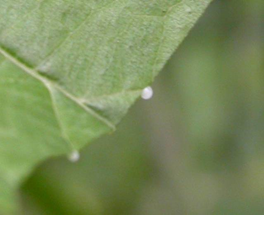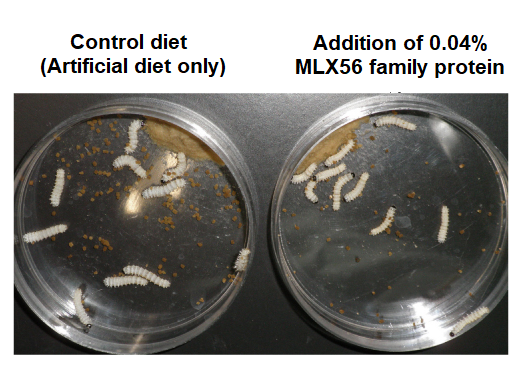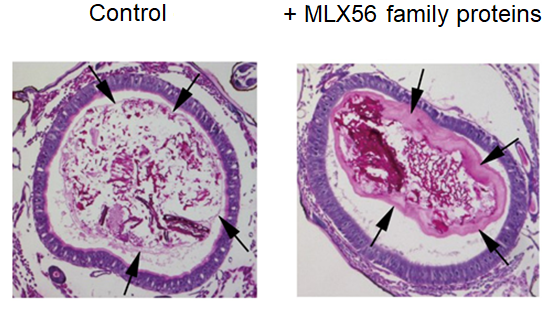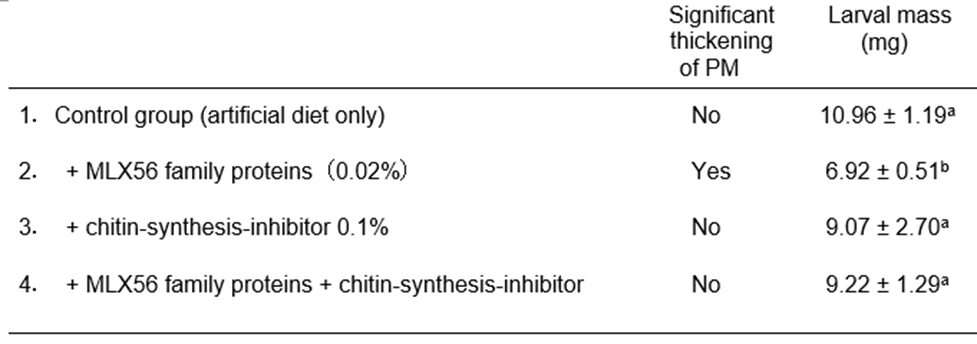The proteins contained in the latex of mulberry have been clarified to abnormally thicken the thin peritrophic membrane (PM) in the digestive tract of insects inducing the suppression of digestion and inhibition of growth. A protein with this mode of action (i.e. thickening of PM) for inhibiting the growth of insects has not been found so far and could therefore be used as a new material for insect pest control.
Overview
Plants are immobile and are therefore known to produce substances such as proteins which act like "poison" to prevent being eaten by insects and other organisms. Such substances can be used as pesticides for controlling insect pests. With the appearance of insects that develop resistance to traditional pesticides, these proteins are drawing attention and could potential source of materials that may lead to the development of new formulation of pesticides.
Mulberry leaves are well known as natural silkworm diet, but most other insects besides silkworms do not make use of mulberry as food source. The Institute of Agrobiological Sciences, NARO (NIAS) has discovered that certain proteins (MLX56 family proteins) contained in mulberry latex inhibit pest growth with a completely new mechanism that has never been reported. This family of proteins were found to cause digestive disfunction by abnormally thickening the thin peritrophic membrane in the digestive tract of larvae of moths. Moreover, it inhibits the growth of larvae remarkably even if it is added to the diet at an extremely low concentration of 0.01-0.04%.
Proteins of MLX 56 family are promising candidates as materials for new technology development to protect plants from pests.
Publication
Konno K, Shimura S, Ueno C, Arakawa T, Nakamura M (2018) Abnormal swelling of the peritrophic membrane in Eri silkworm gut caused by MLX56 family defense proteins with chitin-binding and extensin domains. Phytochemistry 147:211-219.
For enquiries
Contact: http://www.naro.go.jp/english/inquiry/index.html
Reference Information

Figure 1.Mulberry latex containing a large amount of MLX56-family protein
(White droplets exuded from mulberry leaves)

Figure 2.Growth inhibitory effects of MLX56-like protein
The growth of the Eri silkmoth larvae (right dish) fed an artificial diet containing MLX56 family proteins at a low concentration of 0.04% was inhibited and larvae were smaller compared to the larvae (left dish) fed with artificial diet without MLX56 family proteins. Also, in the Eri silkmoth larvae (right dish) which fed the MLX56 family protein-containing diet, the number of feces was approximately 30% less than the larvae (left dish) fed diet without MLX family proteins. This showed that the digestive process was inhibited and the growth became slow.

Figure 3. Abnormal thickening of the peritrophic membrane (PM)
in Eri-silkworm fed MLX56 family protein-containing diet
Cross sectional image of gastrointestinal tract of the Eri silkworm larvae fed diet containing MLX56 family proteins (right). Light purple-colored ring-like structure (arrows) is abnormally thick peritrophic membrane (PM) whereas in the control (left) which was fed diet without MLX56-family proteins, the PM was very thin. The dark purple ring-like part surrounding the PM is gastrointestinal cells.

Figure 4. Mechanism by which MLX 56family protein thickens the PM
Table 1.The growth-inhibitory effect of MLX56 family proteins on the Eri silkworms and thickening effect of peritrophic membrane (PM) by chitin synthesis inhibitor

Neonate Eri-silkmoth larvae (1.5 mg) were fed one of the above diets for 2 days (48 h), and the larval mass (average ± SD, n=10) was measured. The values of larval mass not followed by the same letters are signi?cantly different (P < 0.05; Tukey multiple comparison test). Under the condition where the synthesis of chitin was inhibited (treatment 4 in table), the thickening of PM was not observed even with the presence of MLX56 family proteins. The results showed that thickening of PM coincides with growth inhibition. Hence it is clear that thickening of the PM by the action of MLX 56 family protein is the primary cause of growth inhibitory activity of MLX56 family proteins against insects.




